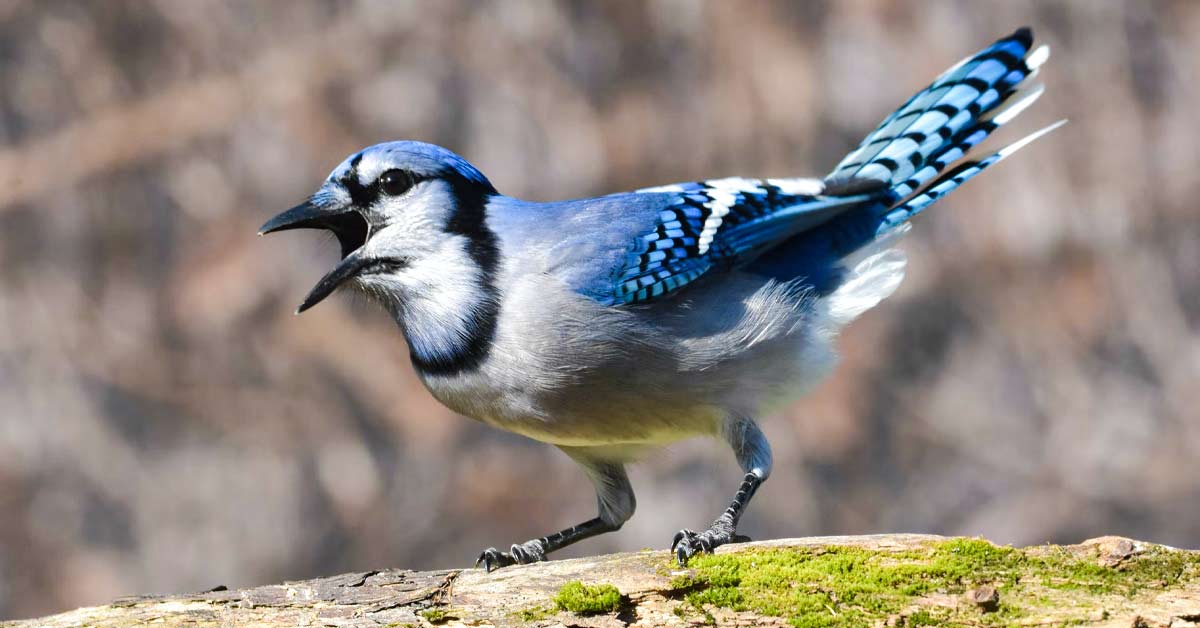The Keystone State is home to over 400+ bird species, about 40 of these are considered song birds of PA. In this post, I’ll introduce you to 12 of my favorite Pennsylvania songbirds, many of them are the most common in terms of population.
Pennsylvania’s abundance of mountains, rivers, hills, forests, and other bird-friendly areas encourage more and more birds to reside year-round or migrate here seasonally.
Being a Pennsylvania girl, this post is extra special to me. Most of these birds I’ve seen from the comfort of my front porch!
If you’re in town and want to go bird-watching, make sure to check out these songbirds of Pennsylvania first for easier identification.
12 Song Birds of PA You Should Seek Out
1. American Robin (Turdus migratorius)
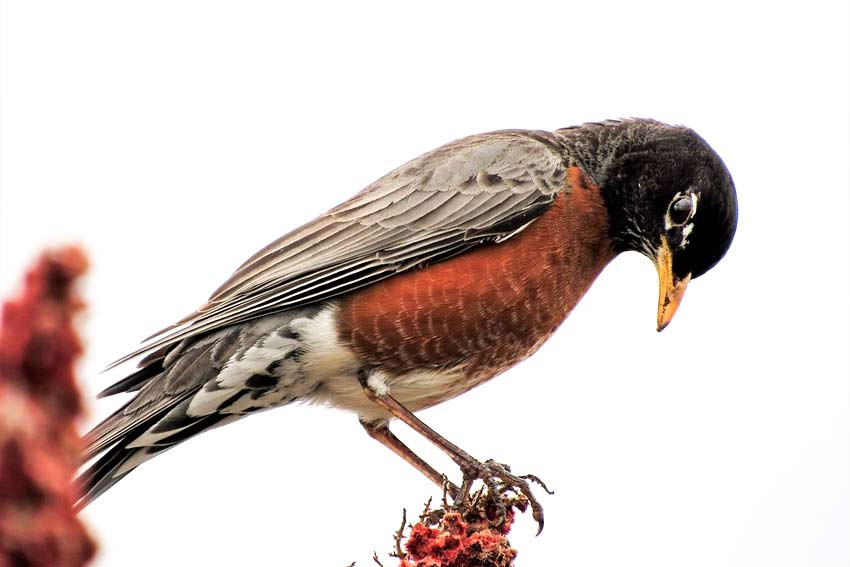
The American robin is a migratory songbird and the most abundant bird in Pennsylvania (with over 370 million population in the US alone).
Appearance: What do American Robins look like?
- Length: 22 to 28 cm
- Weight: 2 to 3 ounces
- Wingspan: 30 to 41 cm
American robins have a mix of brown and black plumage with a striking reddish-orange breast. Some varieties have lighter peach color, while others can get as dark as maroon.
They have a round body, long legs and longish tail.
Sound: What do American Robins sound like?
American Robins sound off several songs, such as “Tut, tut, tut!” and “Peek!” during mating or “Zeeep” sounds when alerting fellow birds about a threat.
American Robins are known to have wonderful songs, some of which end in a laugh-sounding tweet. Females are attracted to the most vocal songster male, so expect males to be louder.
Where to find American Robins in Pennsylvania
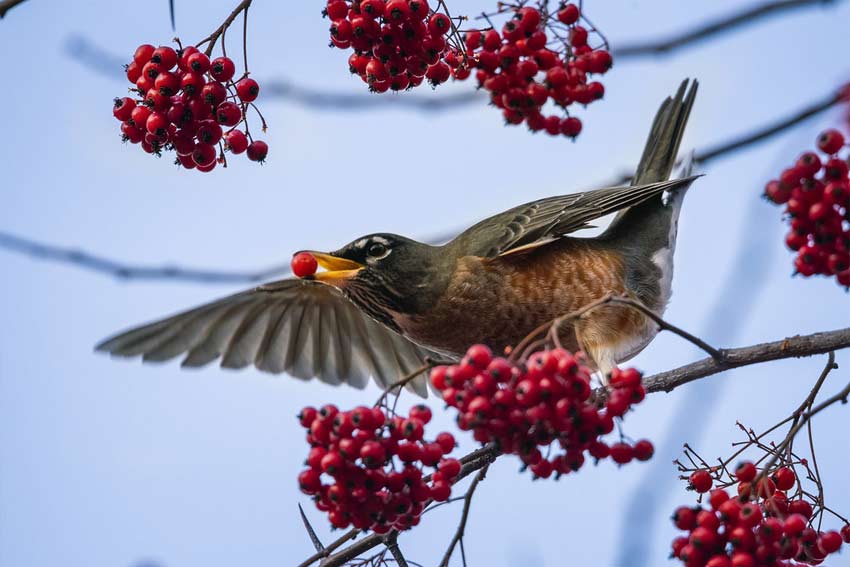
In Pennsylvania, they stay in yards, parks, golf courses, fields, gardens, wooded forests, and other open habitats.
American robins are a common sight in Pennsylvania yards throughout spring and summer.
In the fall and winter, you might see these birds gather in trees to roost or eat berries.
2. American Goldfinch (Spinus tristis)
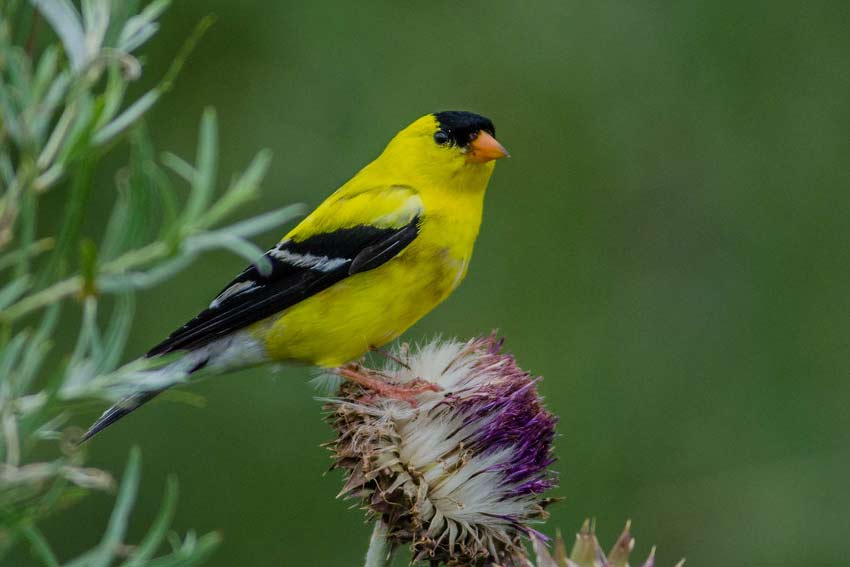
If you do cross paths with the American Goldfinch in Pennsylvania, it would be hard for you not to identify it correctly, especially if you see a male with its bright-yellow color.
Appearance: What do American Goldfinches look like?
- Length: 11 to 14 cm
- Weight: 0.4 to 0.7 ounces
- Wingspan: 19 to 22 cm
Also known as “Wild Canary” or “Lightning Bird” for the male’s unmistakable bright-yellow plumage, the American Goldfinch also features a black “cap” and wings and a yellow beak.
The females have a pale yellow to dull gray color, which is also how males look when they shed in the winter.
Sound: What do American Goldfinches sound like?
American Goldfinch has a famous call that sounds like “po-ta-to chip,” which is just one of the six vocalizations it is known for.
Where to find American Goldfinches in Pennsylvania
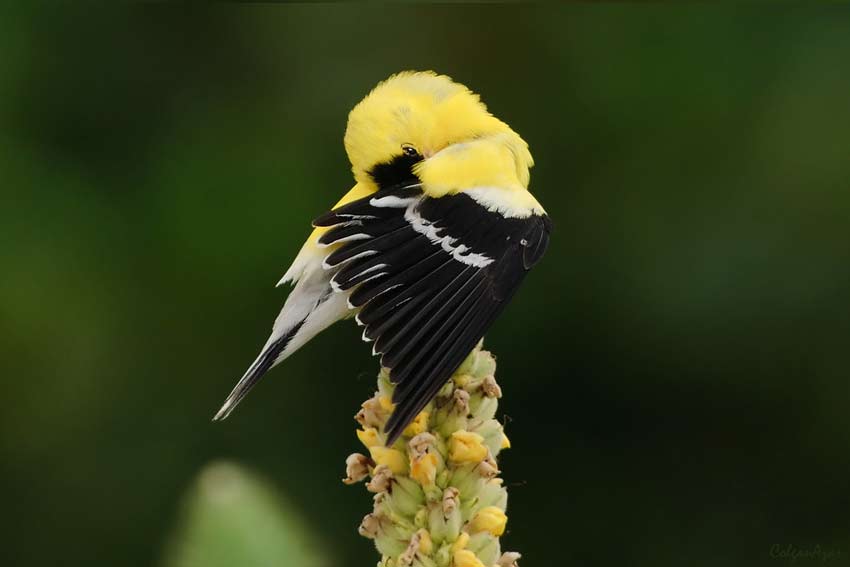
The American goldfinch is very common in Pennsylvania and they’re here year-round.
Their habitat includes floodplains, roadsides, fields, orchards, and backyards.
American Goldfinches are vegetarians, so they stick to eating sunflower, canary, Nyjer, and all kinds of seeds, which is great for Pennsylvania locals who want to attract these songbirds with yard feeders.
3. Blue Jay (Cyanocitta cristata)

Over half a million blue jays live in Pennsylvania.
The Blue jays’ love for acorns is also a reason why thousands of them migrate south.
They also eat peanuts, mealworms, sunflower seeds, suet, berries, and other small fruits.
Appearance: What do Blue Jays look like?
- Length: 25 to 30 cm
- Weight: 2.5 to 3.5 ounces
- Wingspan: 34 to 43 cm
Blue jays are predominantly bright blue in color with hints of white to gray on its throat, chest and underbelly.
They often have a grayish blue crest on the head and black bill, as well as black-and-white bars on their tails and wings.
Sound: What do Blue Jays sound like?
When they mate or hunt for food, blue jays can be aggressive and noisy.
But once they get back to their nest, these beautiful songbirds keep a quiet demeanor.
Blue Jays are one of the popular kids in all of Pennsylvania songbirds since they’re the ones to first sound off an alarm when predators are near, or direct other birds when one finds a food source.
Where to find Blue Jays in Pennsylvania
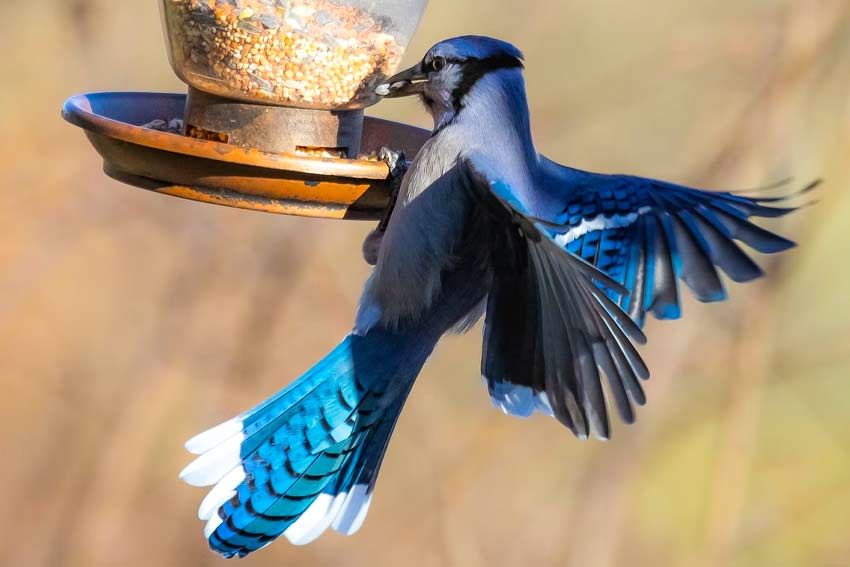
Blue jays are found in Pennsylvania year round, but they’re likely to spread out more during the winter.
If you want to see bands of blue jays flying overhead, the best place to go is Lake Eerie, around spring.
4. Baltimore Oriole (Icterus galbula)
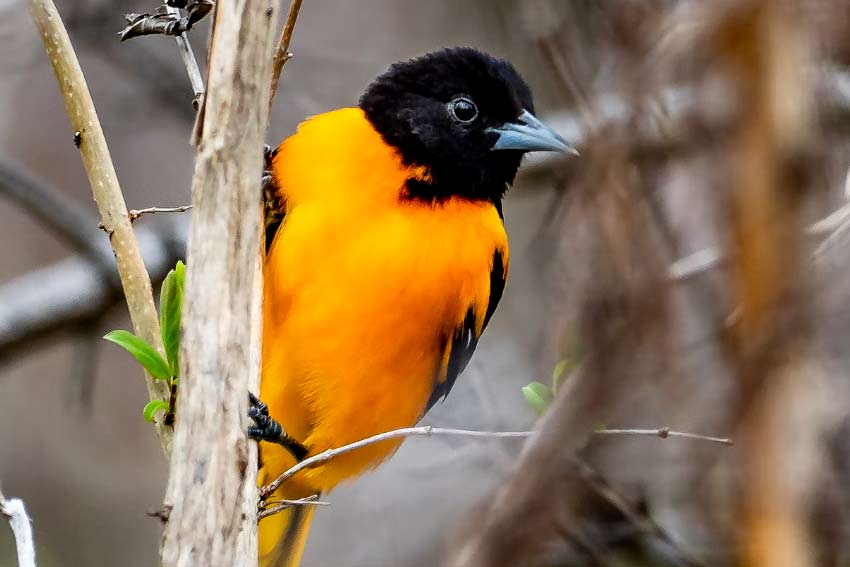
Baltimore Orioles are a member of the Icteridae family and as such, are considered as blackbirds.
Appearance: What do Baltimore Orioles look like?
- Length: 15 to 20 cm
- Weight: 1 to 1.5 ounces
- Wingspan: 23 to 30 cm
With their striking yellow-orange plumage, contrasting all-black face, wings and feet, Baltimore Orioles can be a memorable sight.
Females have duller colors and do not have a black back and hood.
Sound: What do Baltimore Orioles sound like?
Male Baltimore orioles are mostly the ones who sing with whistling tones (often as a territory claim).
Females have shorter songs for communicating with their mate. If you’re lucky, you may even hear mated pairs duet.
Where to find Baltimore Orioles in Pennsylvania
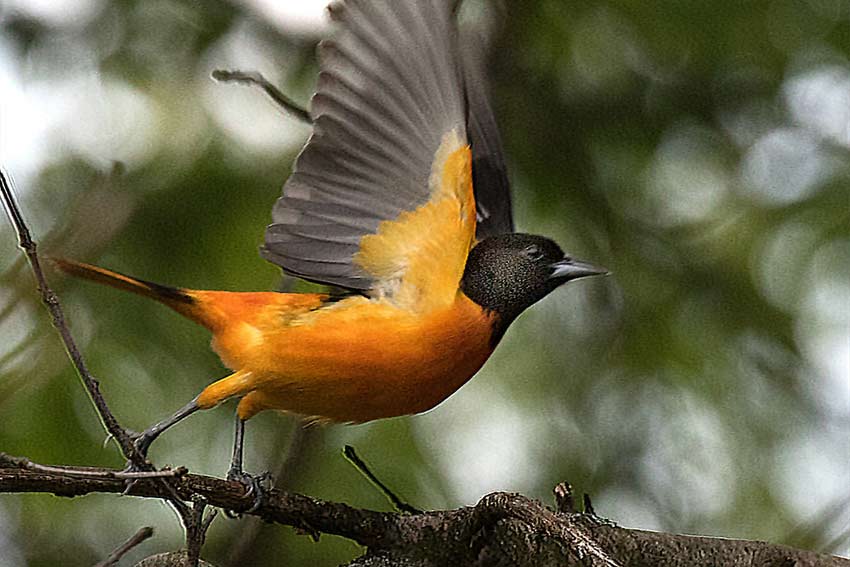
Baltimore Orioles show up in Pennsylvania backyards every spring, especially if you leave orange halves, cherries, mulberries, and other ripe fruit for them to slurp.
You can see them in trees weaving nests, swamps, woodlands, riverbanks, and forests.
5. Black-Capped Chickadee (Poecile atricapillus)

Black-capped chickadees are chunky, little songbirds that are friendly yet super-tough.
They do not migrate and get through the cold winters of Pennsylvania.
Appearance: What do Black-Capped Chickadees look like?
- Length: 10 to 15 cm
- Weight: About 0.5 ounces
- Wingspan: 15 to 20 cm
Black-capped chickadees are known for their plump gray and white bodies, big heads with a black cap, black beaks, beady black eyes, and white streaks on the cheeks, contrasted with dark grays and white stripes on their wings and tails.
Sound: What do Black-Capped Chickadees sound like?
These songbirds are known for their two-tone whistling and their “chick-a-dee-dee-dee” calls.
Where to find Black-Capped Chickadees in Pennsylvania
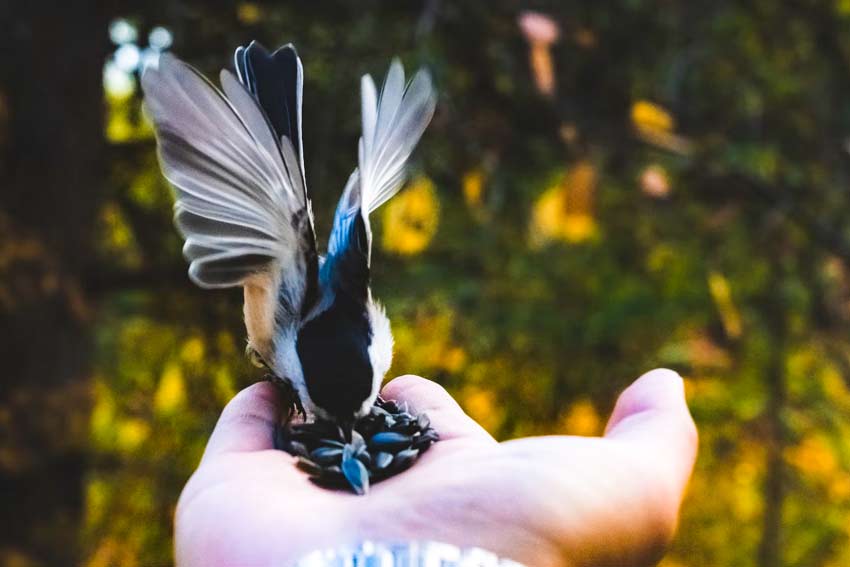
Black-capped chickadees are common throughout Pennsylvania, except for the southern counties of the state where hybrids are found.
They are mostly found in woodlands and can be quite friendly (and even eat from a human’s hands) if given their favorite seed mixes on feeders.
6. Chipping Sparrow (Spizella passerina)
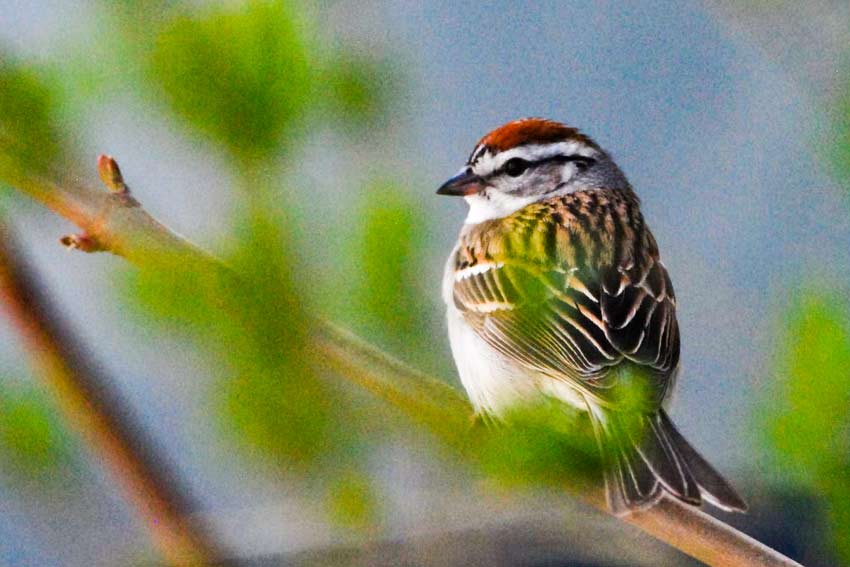
Chipping Sparrows are common song birds of PA. They’re incredibly adorable with their small size and black “eyeliner.”
Appearance: What do Chipping Sparrows look like?
- Length: 13 to 14 cm
- Weight: 0.4 to 0.6 ounces
- Wingspan: Around 21 cm
Because there are several types of sparrows that visit Pennsylvania, it can be sometimes challenging to spot a Chipping Sparrow.
However, you can look closely at its plain white or gray breast and reddish-brown cap.
In the winter, the colors of a typical Chipping sparrow dull a bit. Juveniles look more streaky than adults.
Sound: What do Chipping Sparrows sound like?
Chipping Sparrows are known for their buzzing, “bouncing-ball” sound or machine-like trill in the spring.
Where to find Chipping Sparrows in Pennsylvania

You can find Chipping Sparrows in woodlands, open areas, forests, and even in suburban settings.
In the fall and winter, these birds gather in flocks. Check shrubs on the ground where they often scourage for seeds, grains, and fallen berries.
7. Dark-eyed Junco (Junco hyemalis)
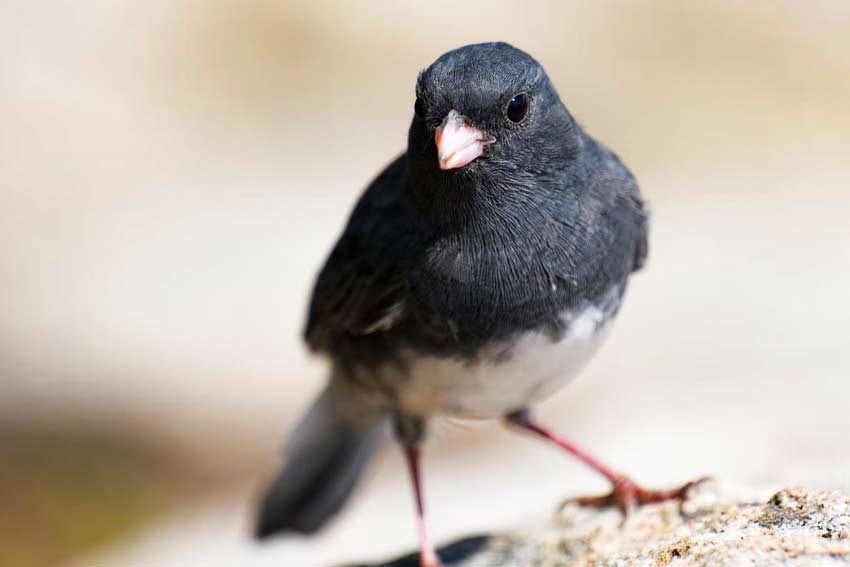
The Dark-eyed Junco is just one of the many Northern Junco subspecies of this dark-colored sparrow.
Appearance: What do Dark-eyed Juncos look like?
- Length: 12.5 to 16.5 cm
- Weight: 18 to 30 ounces
- Wingspan: About 23.5 cm
Like other songs birds of PA, the colors of Dark-eyed Juncos change from juveniles to adults and by gender and seasons.
But all of them have dark eyes, gray hoods and backs, white bellies, dark tails, pinkish or light gray triangular beaks, and distinctive white tail feathers.
Sound: What do Dark-eyed Juncos sound like?
The sound of a Dark-eyed Junco is similar to the Chipping Sparrow.
One of its musical trills consists of 5 to 20+ fast notes, lasting up to a second or two.
Where to find Dark-eyed Juncos in Pennsylvania
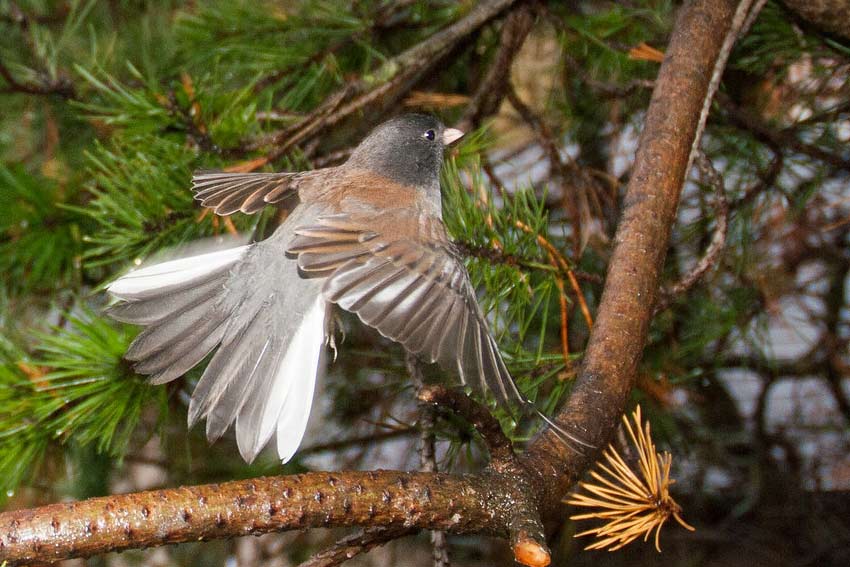
The habitat of Dark-eyed Juncos includes forests, wooded areas, and weedy fields, where they can easily forage on the ground for seeds.
8. Gray Catbird or Grey Catbird (Dumetella carolinensis)
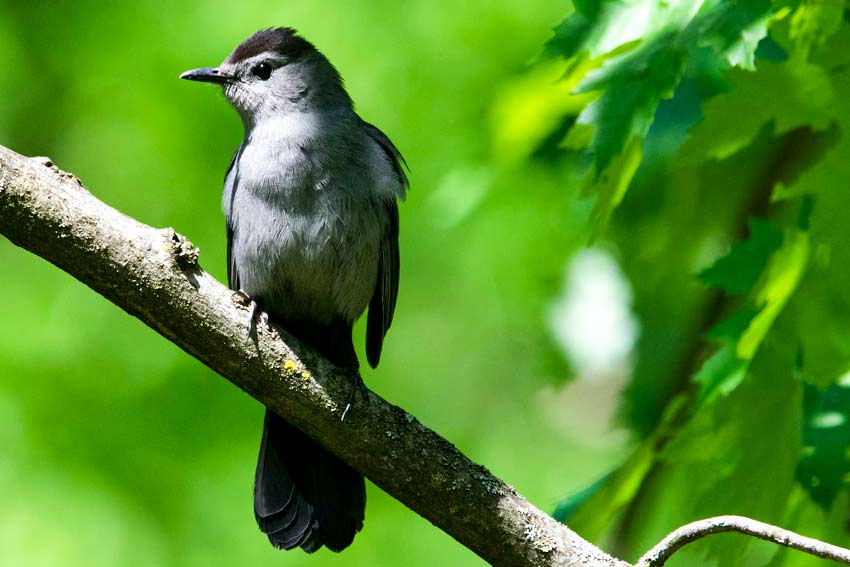
As their name suggests, these Grey Catbirds “meow” as one of their calls.
Appearance: What do Gray Catbirds look like?
- Length: 20.5 to 24 cm
- Weight: 0.8 to 2 ounces
- Wingspan: 22 to 30 cm
Sound: What do Gray Catbirds sound like?
Gray catbirds are pretty vocal. Aside from their typical meowing, you may also hear them whistle and go on a string of loud chirps.
Where to find Gray Catbirds in Pennsylvania
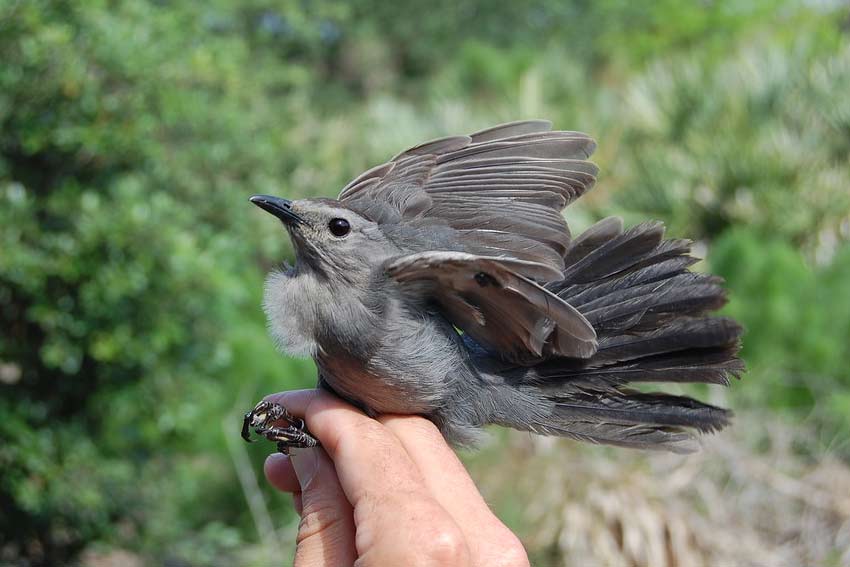
Gray Catbirds are abundant and found statewide in Pennsylvania.
You can find then inhabiting areas with nearby water. Interestingly, these song birds of PA won’t readily be attracted to feeders but would be present in birdbaths.
9. Northern Cardinal (Cardinalis cardinalis)

These exotic-looking song birds of PA can be pretty mesmerizing for birders and non-birders alike.
Appearance: What do Northern Cardinals look like?
- Length: 21 to 24 cm
- Weight: 1.5 to 2 ounces
- Wingspan: 25 to 31 cm
Males have bright red feathers, which interestingly come from the carotenoids of the food they eat.
If they can’t find these food items, their red hues fade into a light-to-dark brownish color. Females normally have brown plumage with red tints on their crest, wings, and tails.
Another striking feature of the Northern Cardinal is their big triangular beaks emphasized by the black feathers around the beaks.
Sound: What do Northern Cardinals sound like?
The Northern Cardinal has a warbling or slurred song, consisting of sped-up loud whistles that close with a slow trill.
Where to find Northern Cardinals in Pennsylvania
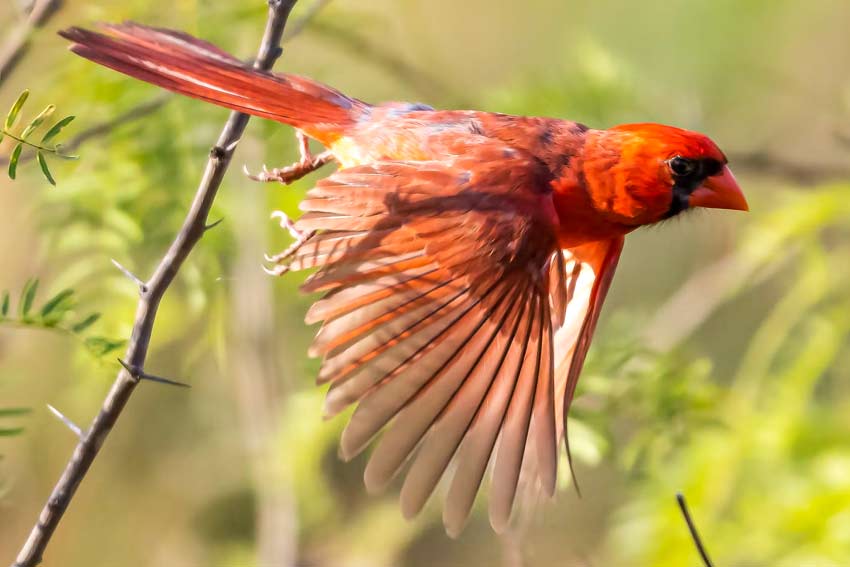
According to Pennsylvania’s Game Commission, the Northern Cardinals are common throughout all of Pennsylvania except for heavily forested areas on the Allegheny High Plateau.
10. Mourning Dove (Zenaida macroura)
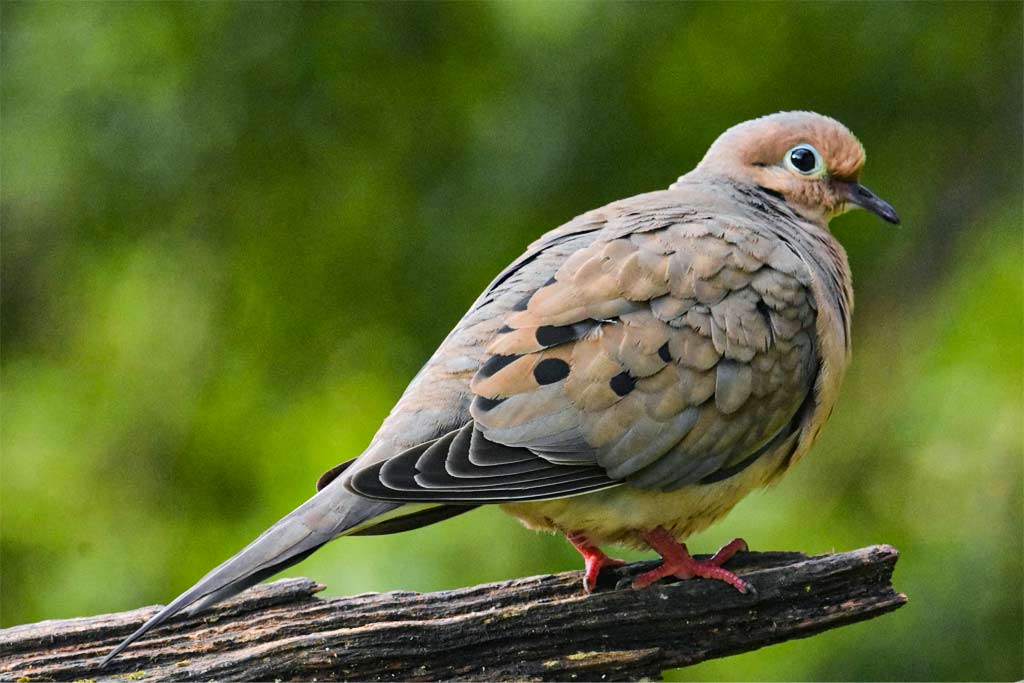
Also called “American Mourning dove” or Rain Dove, this fluffy dove is a member of the dove family, Columbidae.
It is one of the most widespread US birds with about 400 million in population.
Appearance: What do Mourning Doves look like?
- Length: 22 to 36 cm
- Weight: 4 to 6 ounces
- Wingspan: 35 to 45 cm
It’s easy to identify Mourning Doves. They have pale peach feathers, long but thin tails and black spots covering their fluff-like wings.
Sound: What do Mourning Doves sound like?
Mourning doves have an eerily sad-sounding coo (hence their name). They also have whistling, whinnying calls.
Where to find Mourning Doves in Pennsylvania
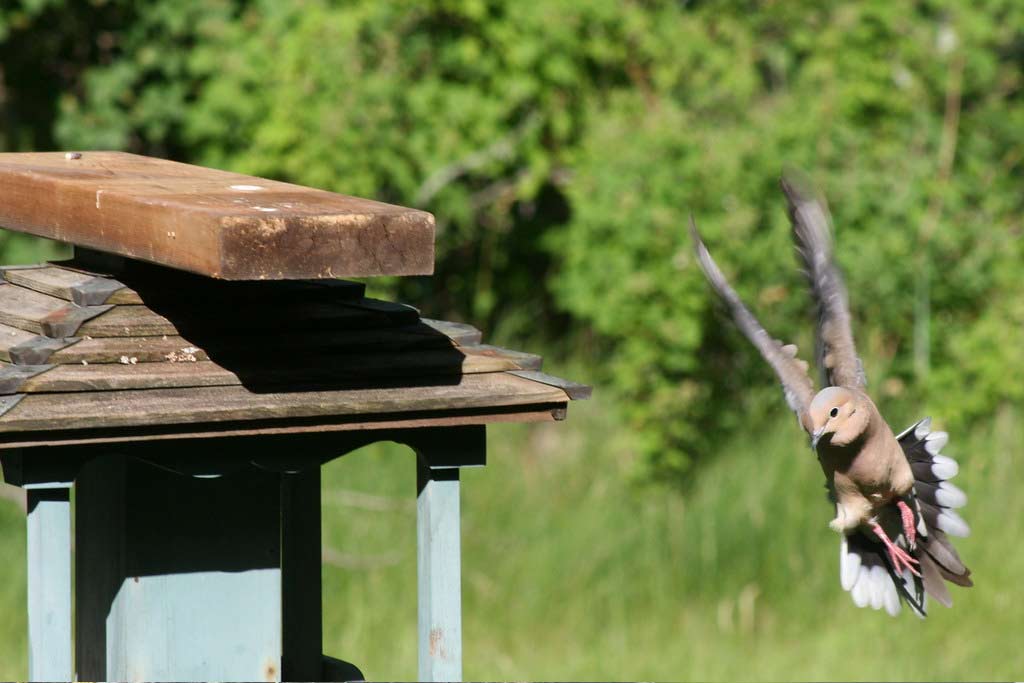
While Mourning doves are found in PA year round, you’ll find the most number of these birds in August, usually hanging out on phone lines, farms, open fields, backyards, and even along highways.
11. Rose-breasted Grosbeak (Pheucticus ludovicianus)
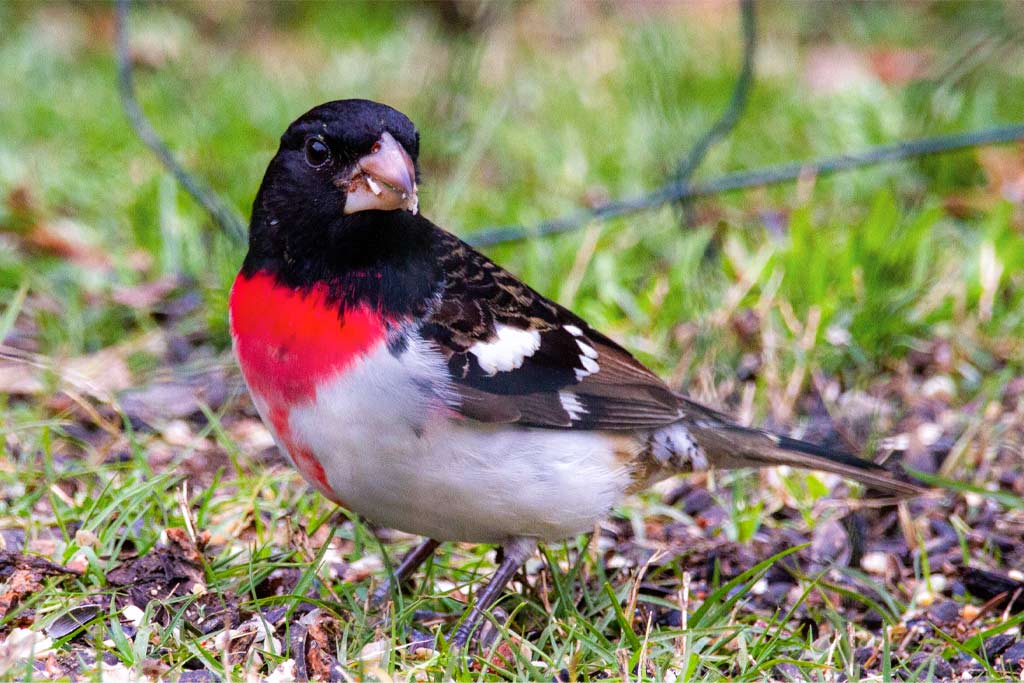
Colloquially called by birders as “cut-throat” due to its bloody-throat appearance, the rose-breasted grosbeak is an easy-to-identify mainstay songbird in Pennsylvania.
Appearance: What do Rose-breasted Grosbeaks look like?
- Length: 18 to 22 cm
- Weight: 1.2 to 3 ounces
- Wingspan: 29 to 33 cm
Males have a black-and-white plumage with a bright red spot on their chest.
Females are harder to spot because they look a LOT different from their male counterparts. Female Rose-breasted Grosbeaks have brown and white feathers.
Sound: What do Rose-breasted Grosbeaks sound like?
Rose-breasted grosbeaks sound similar to the American Robin, but with a series of rising-and-falling notes.
Males also have a song when attracting females or establishing territories.
Where to find Rose-breasted Grosbeaks in Pennsylvania
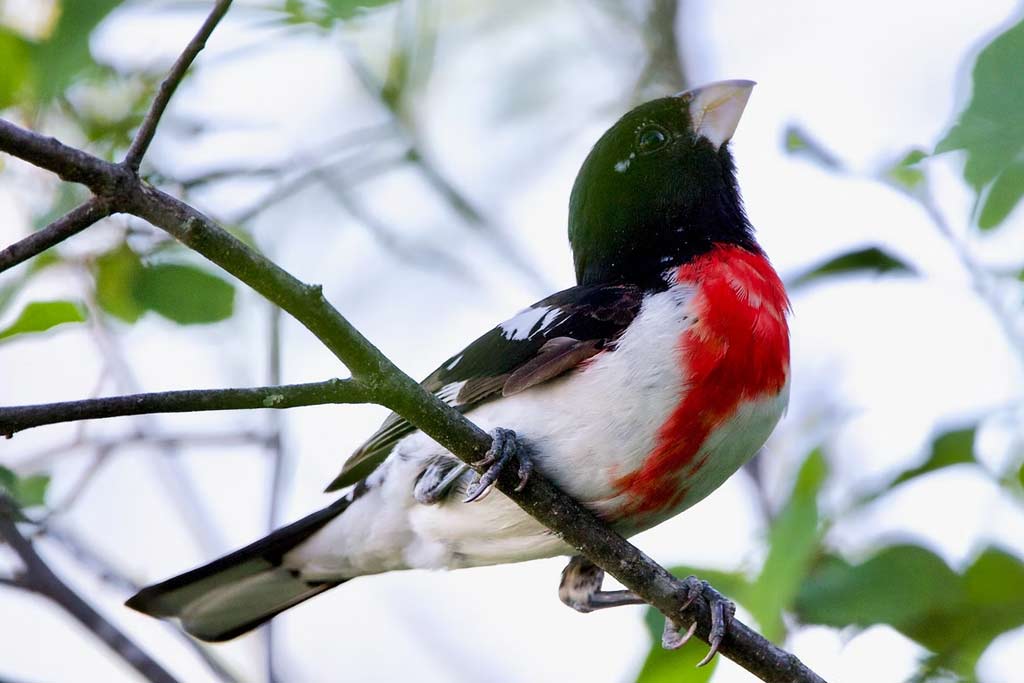
Rose-breasted grosbeaks are a common sight during the fall migration season in the Western part of Pennsylvania.
12. Tufted Titmouse (Baeolophus bicolor)
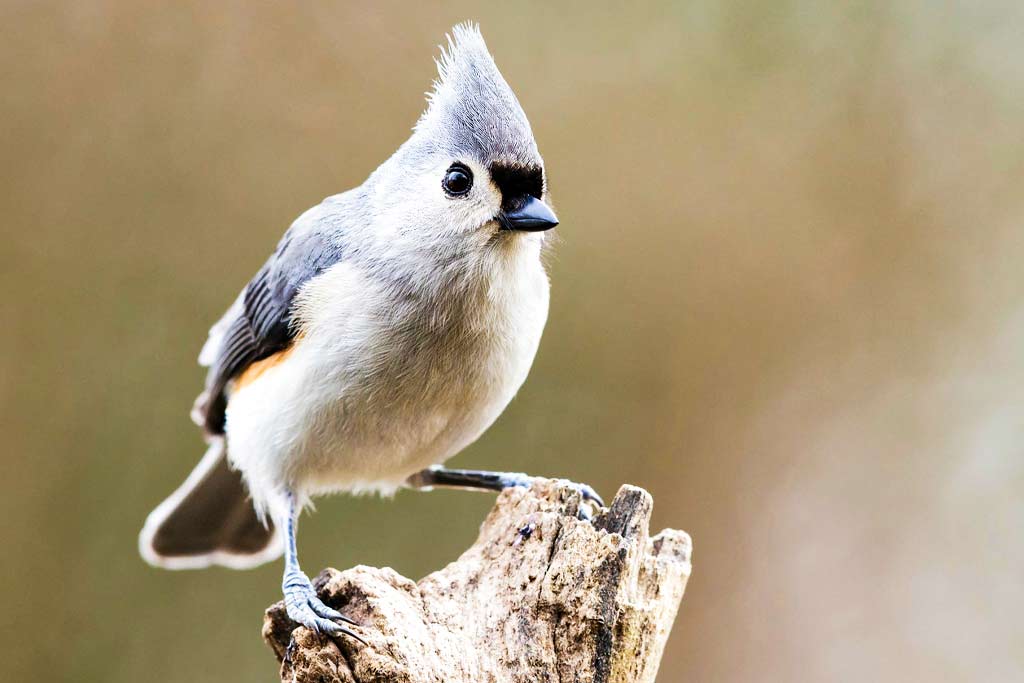
The tufted titmouse (or tufted titmice as NatGeo calls a group of two or more of these PA songbirds), whose look I adore because of its distinct mohawk.
Appearance: What does a Tufted Titmouse look like?
- Length: 15 to 17 cm
- Weight: 0.5 to 1 ounce
- Wingspan: 20 to 26 cm
The “tuft” or the mohawk-looking feathers atop its head makes the Tufted Titmouse easy to identify.
If you’re familiar with the blue jays, these song birds of PA look similar except they’re gray in color with white chest, beady black eyes, and dark beaks.
Sound: What does a Tufted Titmouse sound like?
The sound of Tufted Titmouse is easy to identify thanks to its “peter-peter-peter” song repeated over 10 times. It’s also known to whistle.
Where to find Tufted Titmouse in Pennsylvania
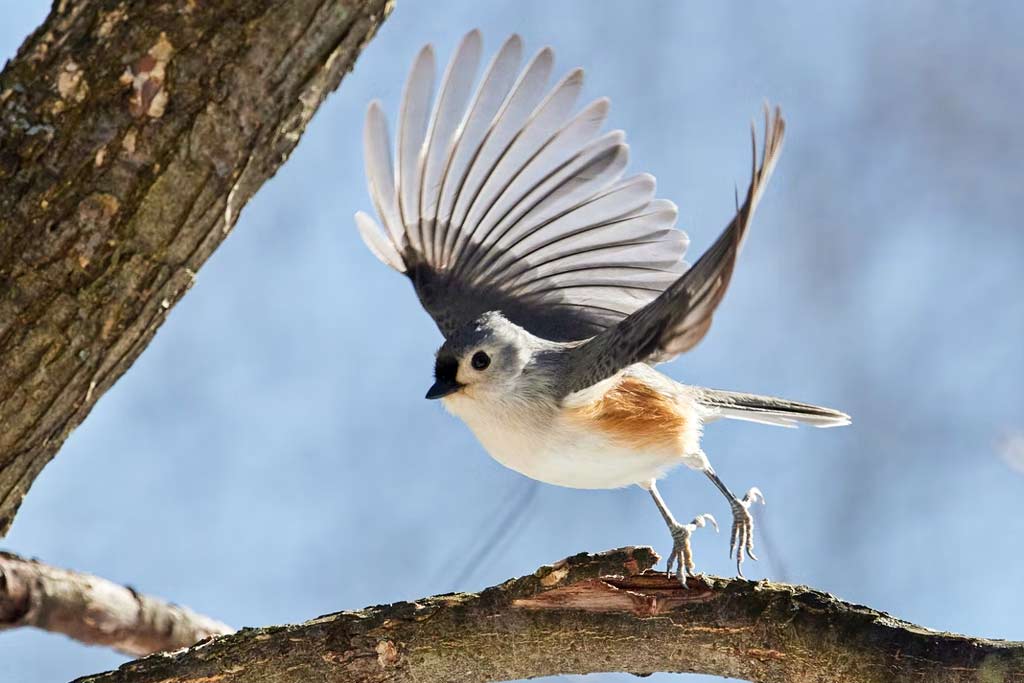
The Tufted Titmouse is a common backyard bird in Pennsylvania.
You can also find them in eastern forests and parks.
Growing Up With Song Birds in PA
I’ve lived my whole life in Pennsylvania and have seen every corner of the state.
With that has come great birding opportunities and these 12 song birds have been an absolute joy to get to experience first hand.
